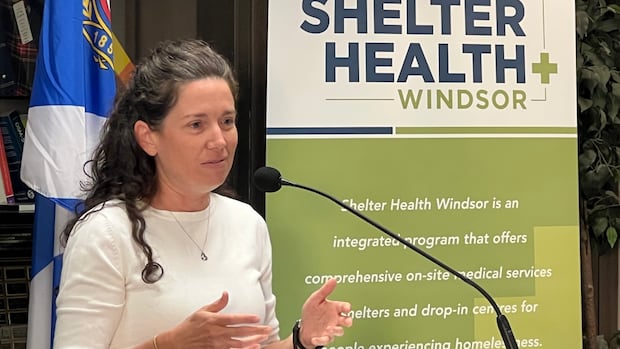I was walking through the doors of the Welcome Centre Shelter for Women & Families when Dorothy, a regular client with weathered hands and a persistent cough, caught my eye. “They finally listened,” she said, clutching a prescription that wouldn’t have existed without the nurse practitioner who visits the shelter twice weekly.
Dorothy’s story came to mind last Thursday when Ontario Health Minister Sylvia Jones announced a $3.8 million investment to expand healthcare services for Windsor’s homeless population. The funding, part of a larger $28 million provincial commitment, will support mobile health teams and specialized care at emergency shelters across the city.
“People experiencing homelessness face unique barriers to accessing healthcare,” Jones said during the announcement at the Downtown Mission. “This investment ensures care comes to them, not the other way around.”
For frontline workers in Windsor’s shelter system, the news couldn’t come soon enough. The city has seen homelessness rates climb by nearly 30% since 2019, according to the Windsor Essex County Health Unit, with approximately 450 people experiencing homelessness on any given night.
Lady Laforet, Executive Director of the Welcome Centre, told me the funding addresses a critical gap. “When someone is worried about where they’ll sleep tonight, making it to a doctor’s appointment across town becomes nearly impossible,” she explained as we toured their facility. “Having healthcare providers on-site removes those barriers.”
The new funding will expand existing programs while creating additional services at five emergency shelters in Windsor, including the Downtown Mission, Welcome Centre, and Salvation Army. Services will include:
- Regular visits from nurse practitioners and mental health workers
- On-site wound care and medication management
- Harm reduction services and addiction support
- Assistance navigating the broader healthcare system
Dr. Wajid Ahmed, Medical Officer of Health for Windsor-Essex County, explained that healthcare for homeless populations requires specialized approaches. “These aren’t just medical interventions,” he said. “They’re relationship-building opportunities that can eventually connect people to housing, mental health services, and addiction treatment.”
The connection between homelessness and health outcomes is stark. A 2022 study published in the Canadian Medical Association Journal found that homeless individuals have mortality rates 5-10 times higher than the general population, with significantly higher rates of chronic conditions like diabetes, heart disease, and respiratory problems.
Joyce Zuk, Executive Director of Family Services Windsor-Essex, has witnessed these disparities firsthand. “We’ve had clients develop serious infections from minor wounds because they couldn’t access basic care,” she said. “Others stop taking critical medications because they have nowhere to store them or lack the support to manage complex treatment plans.”
One of the most promising elements of the new funding is support for “wrap-around” care models. These approaches recognize that healthcare exists within a broader context of social needs.
“You can’t separate physical health from housing security or mental wellbeing,” explained Dr. Fahad Razak, an internal medicine specialist who has researched healthcare access for marginalized populations at the University of Toronto. “When medical professionals can connect with patients in their own environments and coordinate with housing workers, addiction counselors, and social services, we see much better outcomes.”
While touring the Downtown Mission’s current health station—a converted office with basic medical supplies—I met Carlos, a shelter resident who credits the on-site nurse with diagnosing his diabetes. “I thought I was just tired all the time,” he told me, describing symptoms he’d been ignoring for months. “If she wasn’t here, I probably would’ve ended up in the ER eventually.”
Stories like Carlos’s highlight both the human impact and potential cost savings of these programs. A 2021 report from the Canadian Institute for Health Information found that providing consistent primary care to homeless populations can reduce emergency room visits by up to 30% and hospital admissions by 20%.
Critics note that while the funding is welcome, it doesn’t address the root causes of homelessness. Windsor, like many Canadian cities, faces a severe affordable housing shortage, with vacancy rates below 2% and average rents increasing faster than income levels.
Ron Dunn, Executive Director of the Downtown Mission, acknowledged this tension. “Healthcare is crucial, but we need to recognize it’s one piece of a larger puzzle,” he said. “We still need more affordable housing, better mental health systems, and poverty reduction strategies.”
The funding comes at a critical time for Windsor’s shelter system, which has operated beyond capacity for much of the past year. Winter brings additional health challenges, from frostbite and hypothermia to increased respiratory infections in crowded shelter spaces.
As I left the Downtown Mission, I watched a mobile health unit pull up outside—a converted RV with medical equipment and a small exam room. A line quickly formed, mostly people who hadn’t seen a healthcare provider in months or years.
For Dorothy and others like her, these services represent more than just medical care—they’re a pathway to dignity and stability. While the challenges remain immense, this investment recognizes a fundamental truth: health and housing are inseparable, and solutions must meet people where they are.
The new funding will be distributed through Ontario Health West, with services expected to be fully operational across all participating shelters by early 2024.






